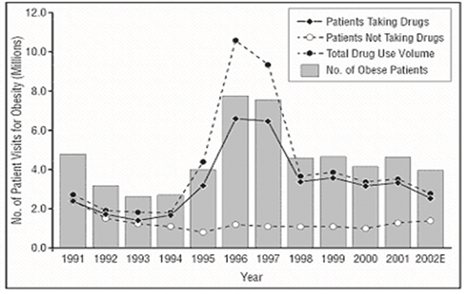
3. Fenfluramine, Dexfenfluramine

Image 2. Chemical formula or fenfluramine.
These appetite suppressants appeared in the late 1970s. Among key neurotransmitters such as dopamine, norepinephrine, and serotonin, they had potent action on serotonin but failed to bring drastic weight loss. Therefore, they were not very popular in the early days.

Image 3. Distribution of obesity patients through time.
In the early 1990s, phentermine with action on dopamine and norepinephrine was combined with fenfluramine with action on serotonin in the so-called Phen-Fen therapy. It became very popular with over 18 million prescriptions of it being made. However, in 1997, it was reported that patients on Phen-Fen therapy developed pulmonary hypertension and valvular heart disease. Etiological studies showed that this was due to overactivation of 5-HT 1b/d receptor of pulmonary artery and 5-HT2b receptor of cardiac valve. Phentermine maintained FDA approval but fenfluramine was withdrawn from the market.
4. Fluoxetine
The year 1987 saw a revolution in the treatment of depression. The role of serotonin in depression was extensively studied leading to introduction of serotonin drugs to replace tricyclic antidepressants with various side effects. It is natural that the potential of serotonin medications as an anti-obesity therapy was studied due to the known effect of fenfluramine on weight loss. Whereas fenfluramine forces secretion of serotonin, fluoxetine inhibited reabsorption of already existing serotonin by pre-synaptic neuron and was deemed safer. Many studies were conducted but evidence on long-term exposure is lacking and large-scale studies have not been conducted since patent expiration. However, off-label prescriptions of fluoxetine is still commonly given in obesity.
We will take a look at more recent drugs from sibutramine to latest introductions in the field of anti-obesity medication.
[Advertisement] Tulip(Skin Tightening & Lifting) – Manufacturer: DANIL SMC(www.danilsmc.com)
-To be continued-




















